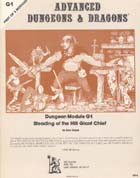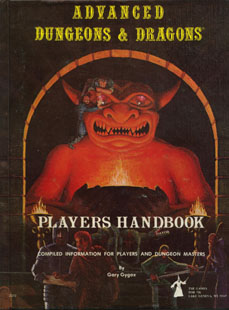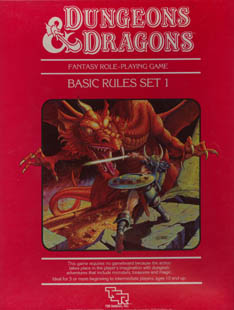By RALF TOTH
Years of growth and lay-offs(1977-1985)
The rules for D&D needed simplification to expand the number of potential buyers. In 1977, the teacher J. Eric Holmes
rewrote the core rules and TSR released the first D&D Basic Game Boxed Set, aimed to meet the growing demand for easy rules for beginners of the game.
This box lead to the break-through of Dungeons & Dragons. In 1978, sales and number of employees doubled due to the new boxed set of rules.
TSR Hobbies dropped the wargaming products and focussed on role-playing and board games. the company moved into a bigger building in Lake Geneva.
The creation of AD&D
Whereas the invention of D&D was the congenial work of Gygax and Arneson, E. Gary Gygax is the undisputed sole father of the AD&D game.
He began the new era by releasing a collection of monsters in a hardbound book under the new Advanced Dungeons & Dragons (AD&D) label - the Monster Manual (September 1977).
 Also, Brian Blume's brother Kevin joined as head of TSR's financial department.
It was not until nearly a year later (June 1978) that TSR ran the first print of the Players Handbook - the true birth of AD&D.
This year also saw the release of the first pastel modules (also called monochrome modules):
The first official AD&D module ever was G1 - Steading of the Hill Giant Chief (see picture to the right), the beginning of the Giant series and it's follow-up, the Drow series, all released in 1978.
The same year the infamous S1 - Tomb of Horrors left the printer and went into the stores. All seven adventure modules of 1978 were written by
E. Gary Gygax.
Also, Brian Blume's brother Kevin joined as head of TSR's financial department.
It was not until nearly a year later (June 1978) that TSR ran the first print of the Players Handbook - the true birth of AD&D.
This year also saw the release of the first pastel modules (also called monochrome modules):
The first official AD&D module ever was G1 - Steading of the Hill Giant Chief (see picture to the right), the beginning of the Giant series and it's follow-up, the Drow series, all released in 1978.
The same year the infamous S1 - Tomb of Horrors left the printer and went into the stores. All seven adventure modules of 1978 were written by
E. Gary Gygax.
 For nearly another year, gamers had to get along without detailed rules for the Dungeon Master until finally, in May 1979 the basic rules set was completed with the
release of the Dungeon Masters Guide.
The same year, official AD&D game tournaments were held at conventions, each with a unique adventure
module: The Lost Tamoachan was used at Origins '79 and the
Ghost Tower of Inverness was played at Wintercon VIII (Detroit, Nov. '79)
- both of them are among today's most wanted and most valuable AD&D items.
Official adventure modules continued to be released by TSR, with
T1 - The Village of Hommlet and S2 - White Plume Mountain, the first AD&D module not written by E. Gary Gygax, but Lawrence Schick.
For nearly another year, gamers had to get along without detailed rules for the Dungeon Master until finally, in May 1979 the basic rules set was completed with the
release of the Dungeon Masters Guide.
The same year, official AD&D game tournaments were held at conventions, each with a unique adventure
module: The Lost Tamoachan was used at Origins '79 and the
Ghost Tower of Inverness was played at Wintercon VIII (Detroit, Nov. '79)
- both of them are among today's most wanted and most valuable AD&D items.
Official adventure modules continued to be released by TSR, with
T1 - The Village of Hommlet and S2 - White Plume Mountain, the first AD&D module not written by E. Gary Gygax, but Lawrence Schick.
The Egbert incident
In 1979, D&D received major coverage in the news media, when the college student and D&D player James Dalles Egbert III disappeared without a trace.
Rumours spread, suggesting that Egbert had died in an incident involving the creation of a live-acted version of D&D, played in the sewers beneath the university.
Egbert returned later alive and without a scratch, but the legend was born and the game had received free promotion in the news coverage.
Quick growth, GREYHAWK and other new releases
By the end of 1979, TSR employed already over one hundred people. 1980 brought a change to the cover layout. No longer were modules produced in the original monochrome cover, but with color illustrations.
For the first time, an official campaign setting for AD&D was released. It was E. Gary Gygax' own campaign, which
was released to the public with the World of Greyhawk folio.
GREYHAWK was a popular campaign setting and TSR/WOTC continued
to release material (with a short intermission between 1994-1997) until today.
In 1980 and 1981 several modules were released to meet the growing popularity of the AD&D game system, among them I1,
David "Zeb" Cook's first appearance as an AD&D designer).
Finally, the Giants / Drow series concluded with Q1 - Queen of the demonweb pits.
1980 saw also the release of some hardcover material, the Deities & Demigods book appeared and the following year
the recently created UK section of TSR released the Fiend Folio at the GamesFair convention.
Also, in 1980 the Role Playing Game Association™ (RPGA) was formed.
TSR overheats, Blume mismanagement and the resulting financial crisis
In 1981, TSR created an annual turnover of $16.5 million with a 25% pre-tax profit.
Inc. magazine listed TSR Hobbies as one of the hundred fastest-growing, privately held companies in the United States.
The company employed now over 200 people and its board of directors consisted of E. Gary Gygax, Brian Blume and his brother Kevin Blume with the Blumes still holding 60% of the shares.
In 1982 sales doubled again, and TSR broke the $20,000,000 mark. By the end of the year, 350 people worked for TSR.
 Meanwhile, TSR had retained important designers and artists such as Tracey Hickman, who wrote the I3-5 Desert of Desolation series
in 1982/83 and another bestseller with the original Ravenloft adventure a year later.
Such as the artist Larry Elmore, who started working for TSR in 1981.
The creative output grew, TSR released Star Frontiers, a science-fiction rpg. The Basic D&D Game was translated to conquer the foreign markets.
In 1982/83 the RPGA had put out two AD&D module series,
Frank Mentzer's R1-4 and Bob Blake's RPGA3 and RPGA4
(today, all six of these modules range in the upper price category as they had rather small print runs; their collectible value varies in excess of $100 U.S. each).
Meanwhile, TSR had retained important designers and artists such as Tracey Hickman, who wrote the I3-5 Desert of Desolation series
in 1982/83 and another bestseller with the original Ravenloft adventure a year later.
Such as the artist Larry Elmore, who started working for TSR in 1981.
The creative output grew, TSR released Star Frontiers, a science-fiction rpg. The Basic D&D Game was translated to conquer the foreign markets.
In 1982/83 the RPGA had put out two AD&D module series,
Frank Mentzer's R1-4 and Bob Blake's RPGA3 and RPGA4
(today, all six of these modules range in the upper price category as they had rather small print runs; their collectible value varies in excess of $100 U.S. each).
Mentzer's most influential single work was the re-writing of the original Basic D&D game rules. The result was the widely popular
'Red Box' (1983). 1983 also saw the release of the D&D cartoon series on television. The show ran for two years.
The company grew too fast and the management made gross errors. In 1983 they invested into a needlecraft business, miniatures manufacturing and toy ventures. The same year, the Blumes had also sent Gygax to California to set up the D&D Entertainment Corp. with the main purpose of raising money for the planned D&D movie.
All those new divisions burnt money and when Gygax returned a year later to TSR headquarters in Lake Geneva, he found TSR nearly bankrupt. Gygax' in his own words:
"The Blumes had forced me to accept three "outside" directors on the board.
These three petty businessmen, two executives and a lawyer, were absolutely ignorant of the gaming business, and under their direction, and with the Blumes leading
the way, TSR had accumulated $1.5 million debt that they couldn't figure out how to pay. Amongst their ideas were the dropping of the RPGA and the sale of DRAGON Magazine.
After some thought, I presented a long letter to the entire board, outlining the mismanagement of TSR by Kevin Blume, and demanding his resignation and replacement.
The board voted four to two, the Blumes abstaining, to remove Kevin and put in place a pro-tem president, one Richard Koenigs. Some 90 relatives of the Blumes were
removed from the payroll, various corporate owned and leased cars, scores of them, were gotten rid of, unused system office furniture owned and leased was likewise sold or returned,
and two major releases were rushed into print - Unearthed Arcana and Oriental Adventures (both 1985)."
As a result of the cash shortage, TSR reduced the number of staff members to less than 150 in two big lay-offs.
In 1984, more lay-offs reduced the number of employees to less than a hundred.

New worlds: Dragonlance
A major success was the 1984 release of the Dragonlance module series written by Tracey Hickman. By 1988, there were 15 (!) sequels to the original module (DL1 - Dragons of Despair) released.
To support the modules, it was decided to write and publish Dragonlance novels, finally done by the congenial Tracey Hickman and Margaret Weis (1984). Another great success became the first AD&D Dragonlance
computer games. Dragonlance was later published as a campaign setting for AD&D. The campaign products were visually defined by Larry Elmore's great art.
Dragonlance made TSR the number-one publisher of fantasy and science fiction novels in the U.S.
Despite these successes, TSR reduced its staff down to less than 100 in a major lay-off in April.
Back to the roots of wargaming
1985 was an important year for TSR in terms of AD&D releases. With the new BATTLESYSTEM boxed setting,
AD&D received rules for large scale battle scenarios and gamers had the choice to follow the game to it's roots: Wargaming!
The adventure module H1 - Bloodstone Pass by Douglas Niles,
a supermodule for character levels 15 and up, supported the new wargaming expansions.
Read more ...
|